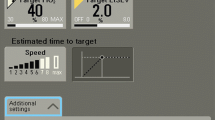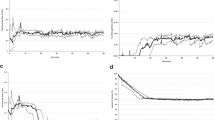Abstract
AGC® (Automatic Gas Control) is the FLOW-i’s automated low flow tool (Maquet, Solna, Sweden) that target controls the inspired O2 (FIO2) and end-expired desflurane concentration (FAdes) while (by design) exponentially decreasing fresh gas flow (FGF) during wash-in to a maintenance default FGF of 300 mL min−1. It also offers a choice of wash-in speeds for the inhaled agents. We examined AGC performance and hypothesized that the use of lower wash-in speeds and N2O both reduce desflurane usage (Vdes). After obtaining IRB approval and patient consent, 78 ASA I-II patients undergoing abdominal surgery were randomly assigned to 1 of 6 groups (n = 13 each), depending on carrier gas (O2/air or O2/N2O) and wash-in speed (AGC speed 2, 4, or 6) of desflurane, resulting in groups air/2, air/4, air/6, N2O/2, N2O/4, and N2O/6. The target for FIO2 was set at 35%, while the FAdes target was selected so that the AGC displayed 1.3 MAC (corrected for the additive affect of N2O if used). AGC was activated upon starting mechanical ventilation. Varvel’s criteria were used to describe performance of achieving the targets. Patient demographics, end-expired N2O concentration, MAC, FGF, and Vdes were compared using ANOVA. Data are presented as mean ± standard deviation, except for Varvel’s criteria (median ± quartiles). Patient demographics did not differ among the groups. Median performance error was −2–0% for FIO2 and −3–1% for FAdes; median absolute performance error was 1–2% for FIO2 and 0–3% for FAdes. MAC increased faster in N2O groups, but total MAC decreased 0.1–0.25 MAC below that in the O2/air groups after 60 min. The effect of wash-in speed on Vdes faded over time. N2O decreased Vdes by 62%. AGC performance for O2 and desflurane targeting is excellent. After 1 h, the wash-in speeds tested are unlikely to affect desflurane usage. N2O usage decreases Vdes proportionally with its reduction in FAtdes.





Similar content being viewed by others
References
Carette R, De Wolf A, Hendrickx JFA. Automated gas control with the Maquet FLOW-i. J Clin Monit Comput. 2016;30:341. doi:10.1007/s10877-015-9723-6.
Rampil IJ, Lockhart SH, Zwass MS, Peterson N, Yasuda N, Eger EI II, Weiskopf RB, Damask MC. Clinical characteristics of desflurane in surgical patients: minimum alveolar concentration. Anesthesiology. 1991;74:429–33. doi:10.1097/00000542-199103000-00007.
De Cooman S, Lecain A, Sosnowski M, De Wolf AM, Hendrickx JFA. Desflurane consumption with the Zeus during automated closed circuit versus low flow anesthesia. Acta Anaesthesiol Belg. 2009;60:35–7. doi:10.1186/1471-2253-8-4.
Nickalls R, Mapleson W. Age-related iso-MAC charts for isoflurane, sevoflurane and desflurane in man. BJA. 2003;91:170.
Varvel JR, Donoho DL, Shafer SL. Measuring the predictive performance of computer-controlled infusion pumps. J Pharmacokinet Biopharm. 1992;20:63–94.
Van Thielen M, Carette R, De Wolf AM, Hendrickx JFA. 2016. Which sevoflurane wash-in rates towards 1.0 MAC ensure adequate anesthetic depth after a standardized intravenous induction before surgical incision? [Abstract] Presented at 2016 annual ISAP meeting. https://www.isaponline.org/application/files/5914/7976/4265/01_Van_Thielen_ISAP.pdf. Accessed 16 April 2016.
Struys M. 2014. From IV induction to inhaled maintenance: how fast should the end-expired % rise? NAVAT. http://www.navat.org/cm/component/content/article/85-taped-sessions/153-2014-06-michel-struys-exhaled-percentage. Accessed 7 November 2016.
Hannivoort LN, Vereecke HE, Proost JH, Heyse BE, Eleveld DJ, Bouillon TW, Struys MM, Luginbühl M. Probability to tolerate laryngoscopy and noxious stimulation response index as general indicators of the anaesthetic potency of sevoflurane, propofol, and remifentanil. Br J Anaesth. 2016;116:624–31.
Author information
Authors and Affiliations
Corresponding author
Ethics declarations
Conflict of interest
Dr. Hendrickx has received lecture support, travel reimbursements, equipment loans, consulting fees, and meeting organizational support from AbbVie, Acertys, Air Liquide, Allied healthcare, Armstrong Medical, Baxter, Draeger, GE, Hospithera, Heinen und Lowenstein, Intersurgical, Maquet, MDMS, MEDEC, Micropore, Molecular, NWS, Philips, Piramal, and Quantium Medical.
Ethical approval
All procedures performed in studies involving human participants were in accordance with the ethical standards of the institutional and/or national research committee and with the 1964 Helsinki declaration and its later amendments or comparable ethical standards.
Informed consent
Informed consent was obtained from all individual participants included in the study.
Rights and permissions
About this article
Cite this article
De Medts, R., Carette, R., De Wolf, A.M. et al. Desflurane usage during anesthesia with and without N2O using FLOW-i Automatic Gas Control with three different wash-in speeds. J Clin Monit Comput 32, 763–769 (2018). https://doi.org/10.1007/s10877-017-0031-1
Received:
Accepted:
Published:
Issue Date:
DOI: https://doi.org/10.1007/s10877-017-0031-1




